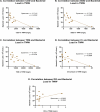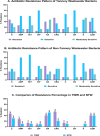Impact of untreated tannery wastewater in the evolution of multidrug-resistant bacteria in Bangladesh
- PMID: 39223208
- PMCID: PMC11369239
- DOI: 10.1038/s41598-024-71472-6
Impact of untreated tannery wastewater in the evolution of multidrug-resistant bacteria in Bangladesh
Abstract
The tannery industry produces one of the worst contaminants, and unsafe disposal in nearby waterbodies and landfills has become an imminent threat to public health, especially when the resulting multidrug-resistant bacteria and heavy metals enter community settings and animal food chains. In this study, we have collected 10 tannery wastewater (TWW) samples and 10 additional non-tannery wastewater (NTW) samples to compare the chemical oxygen demand (COD), pH, biological oxygen demand (BOD), dissolved oxygen (DO), total dissolved solids (TDS), chromium concentration, bacterial load, and antibiotic resistance profiles. While COD, pH, and chromium concentration data were previously published from our lab, this part of the study uncovers that TWW samples had a significantly higher bacterial load, compared to the non-tannery wastewater samples (5.89 × 104 and 9.38 × 103 cfu/mL, respectively), higher BOD and TDS values, and significantly lower DO values. The results showed that 53.4, 46.7, 40.0, and 40.0% of the TWW isolates were resistant to ceftriaxone, erythromycin, nalidixic acid, and azithromycin, respectively. On the other hand, 20.0, 30.0, 50.0, and 40.0% of the NTW isolates were resistant to the same antibiotics, respectively. These findings suggest that the TWW isolates were more resistant to antibiotics than the NTW isolates. Moreover, the TWW isolates exhibited higher multidrug resistance than the NTW isolates, 33.33, and 20.00%, respectively. Furthermore, spearman correlation analysis depicts that there is a negative correlation between BOD and bacterial load up to a certain level (r = - 0.7749, p = 0.0085). In addition, there is also a consistent negative correlation between COD and bacterial load (r = - 0.7112, p = 0.0252) and TDS and bacterial load (r = - 0.7621, p = 0.0104). These findings suggest that TWW could pose a significant risk to public health and the environment and highlight the importance of proper wastewater treatment in tannery industries.
Keywords: Bacterial load; Biological oxygen demand; Chemical oxygen demand; Chromium; Dissolved oxygen; Multidrug-resistance; Tannery wastewater; Total dissolved solids.
© 2024. The Author(s).
Conflict of interest statement
The authors declare no competing interests.
Figures





Similar articles
-
Efficient treatment of tannery wastewater through aeration, coagulation, and algal pond.Water Environ Res. 2023 Dec;95(12):e10952. doi: 10.1002/wer.10952. Water Environ Res. 2023. PMID: 38148734
-
Isolation and characterization of chromate resistant bacteria from tannery effluent.J Environ Biol. 2007 Apr;28(2 Suppl):399-403. J Environ Biol. 2007. PMID: 17929756
-
Isolation and characterization of mercury and multidrug-resistant Citrobacter freundii strains from tannery effluents in Kolkata, India.Arch Microbiol. 2024 Jul 27;206(8):362. doi: 10.1007/s00203-024-04090-5. Arch Microbiol. 2024. PMID: 39066800
-
An insight on the plausible biological and non-biological detoxification of heavy metals in tannery waste: A comprehensive review.Environ Res. 2024 Oct 1;258:119451. doi: 10.1016/j.envres.2024.119451. Epub 2024 Jun 19. Environ Res. 2024. PMID: 38906443 Review.
-
Environmental Pollution, Toxicity Profile and Treatment Approaches for Tannery Wastewater and Its Chemical Pollutants.Rev Environ Contam Toxicol. 2017;240:31-69. doi: 10.1007/398_2015_5009. Rev Environ Contam Toxicol. 2017. PMID: 26795766 Review.
Cited by
-
Comprehensive genomic analysis reveals virulence and antibiotic resistance genes in a multidrug-resistant Bacillus cereus isolated from hospital wastewater in Bangladesh.Sci Rep. 2025 Jul 2;15(1):22915. doi: 10.1038/s41598-025-06655-w. Sci Rep. 2025. PMID: 40594904 Free PMC article.
References
-
- Masood, F. & Malik, A. Environmental concerns of the tanning industry. In Environmental Deterioration and Human Health: Natural and Anthropogenic Determinants (eds Malik, A. et al.) 39–53 (Springer, 2014).
-
- Patel, N. et al. Environmental impact and treatment of tannery waste. In Water Pollution and Remediation: Organic Pollutants (eds Inamuddin et al.) 577–595 (Springer International Publishing, 2021).
-
- Morera, J. et al. Avoiding the production of polluting and toxic chemicals in the tanning process. J. Am. Leather Chem. Assoc.10.34314/jalca.v116i10.4617 (2021). 10.34314/jalca.v116i10.4617 - DOI
MeSH terms
Substances
LinkOut - more resources
Full Text Sources
Medical
Molecular Biology Databases
Miscellaneous

